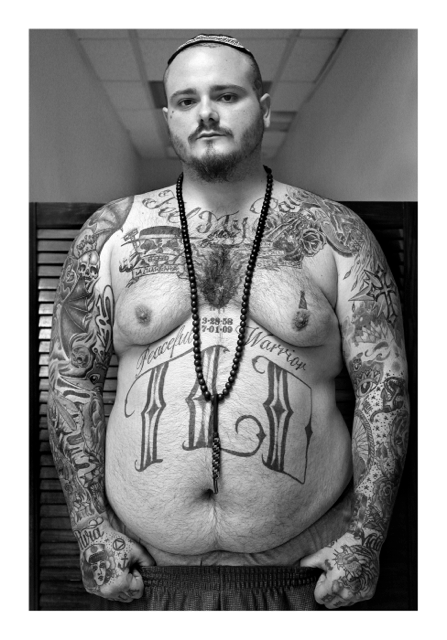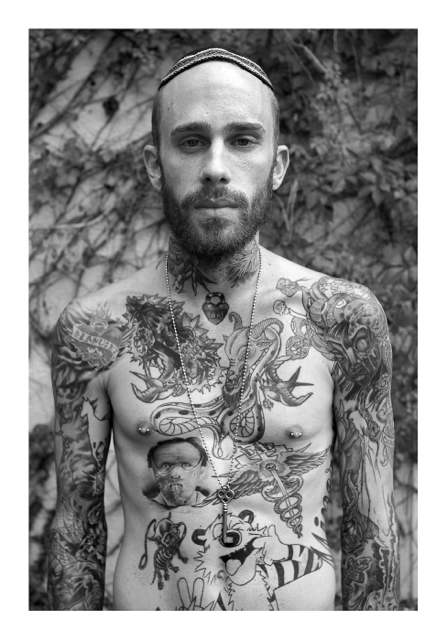
Unorthodox tradition under the lens
One doesn’t need to know the background of the portraits at Fredric Snitzer Gallery to grasp their power. These photographs are immediately and aggressively captivating, in-your-face so. They are also skillfully and beautifully done. There’s real burgeoning talent in Zack Balber, the young artist behind the lens.
Back to the portraits. They are of mostly young, shirtless men, snapped from the waist up, staring straight into the camera. Some are toned, worked-out bodies, others overweight with rolls. But most dramatically, they are all, with some exceptions, covered in detailed, amazing tattoos and wearing a kippah, the Jewish skullcap.
It’s here that a backstory from the artist can change the perception of these images. The solo exhibit is entitled “Tamim,” Hebrew for pure and unblemished; traditionally, those who follow the Jewish religion are not allowed to break this purity by tampering with the skin, such as with body piercings or tattoos. So, on this night, on the eve of Yom Kippur, it added extra power to see these rebels portrayed — all of them acquaintances of Balber, all Jewish and all wearing the artist’s own yarmulke from his Bar Mitzvah.
Tattoos, while increasingly popular and prevalent on bodies all over the world, have always been symbols of power, tribe, rebellion and decoration, often a combination. These are no different. Some are simply lovely; some are surprisingly gentle (like the word “serenity” carved into the inner lower lip of one), others not so much (like the Hannibal Lecter); some mix both Jewish and Christian iconography. What, in the end, is most remarkable is the juxtaposition of the tattooed bodies and the vulnerable faces attached to them. These are truly unorthodox men on an unorthodox journey through the urban jungle and their own heritage.
Although dramatic and hard-edged, these are not dark images. Those are next door, in the appropriately titled “Dark Age Ahead,” which is somewhat based on a book of the same name, depicting a world of “mass amnesia where even the memory of what was lost is lost.” The graphic, multimedia exhibit is from Viking Funeral, a black-haired duo made up of Carlos Ascurra and Juan Gonzalez. The recently added annex to Snitzer’s place is plastered with paper and video/Internet images of a world exploding or burning up, in some images more explicitly than others. But, like other Viking Funeral works, the most powerful element here is the noise and sound backdrop, making this dark universe darker or at least more confusing and incomprehensible — we are well on our way to losing the memory of what already seems inevitably to be lost.
“Tamim” and “Dark Age Ahead” at Fredric Snitzer Gallery, 2247 N.W. First Place, Miami; snitzer.com.
Recent Content
-
Artsarticle ·
-
Artsarticle ·
-
Artsarticle ·



